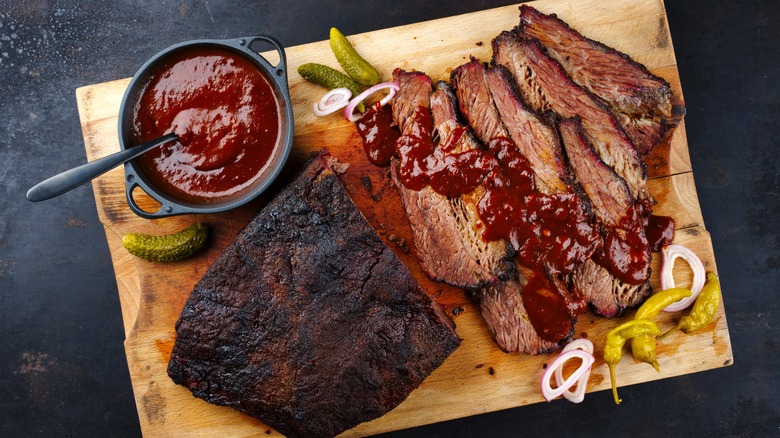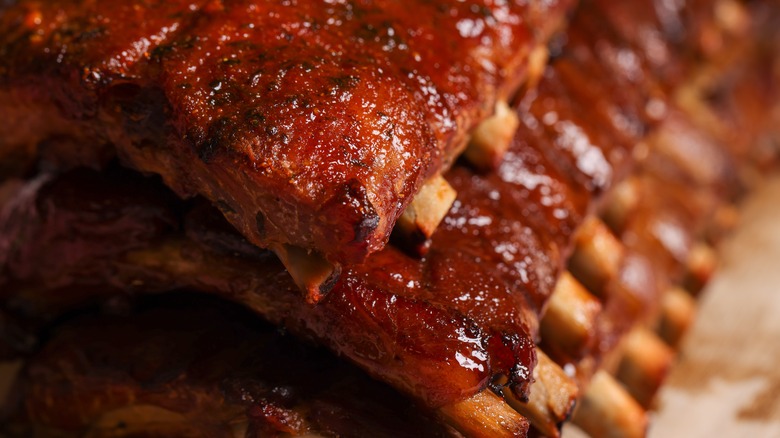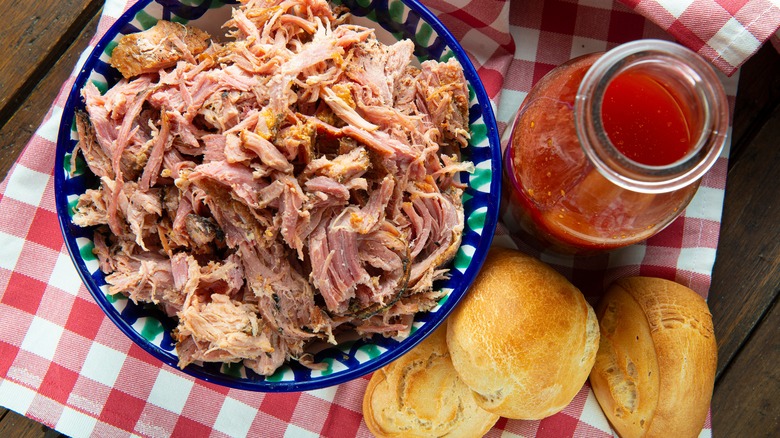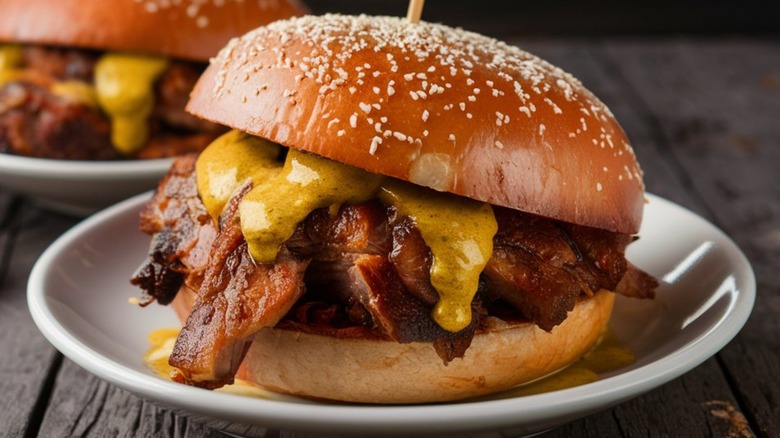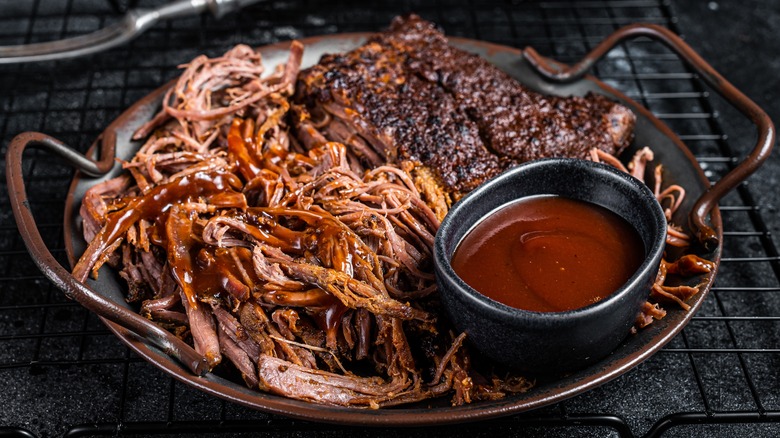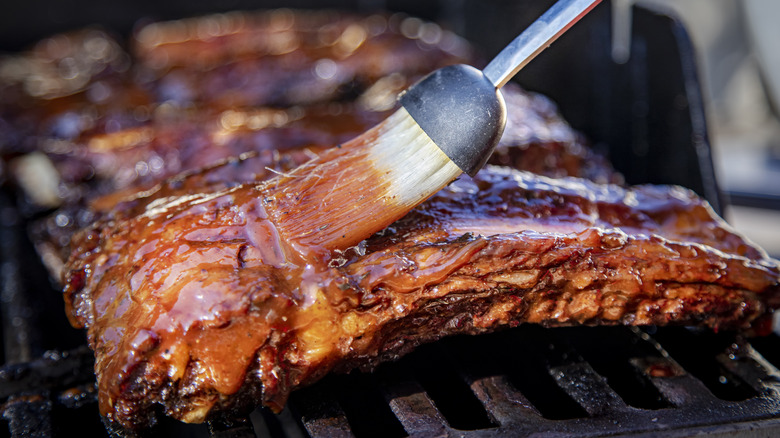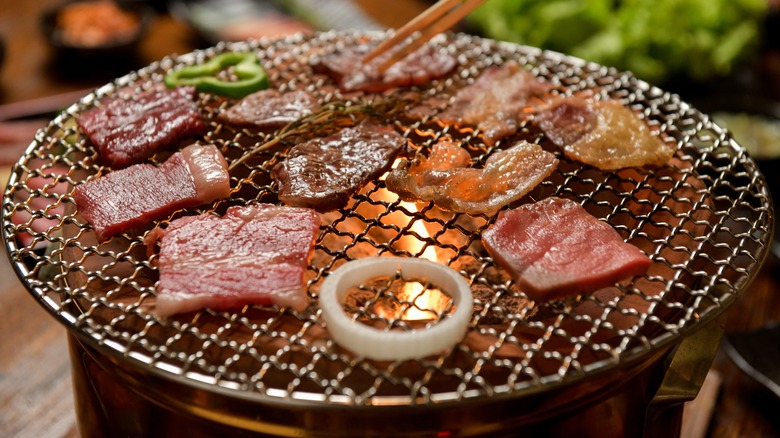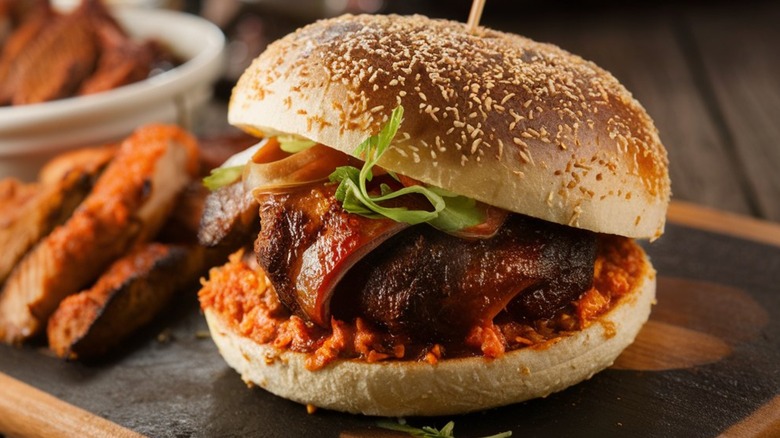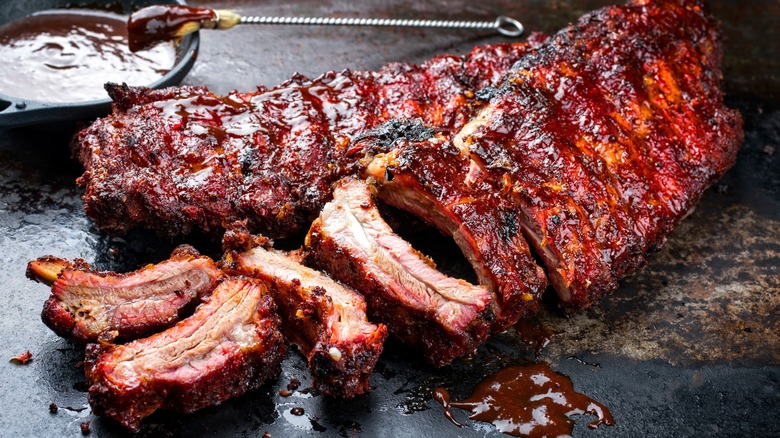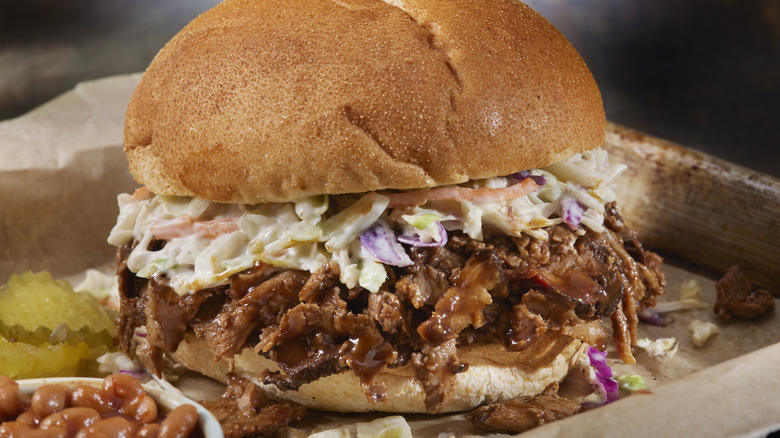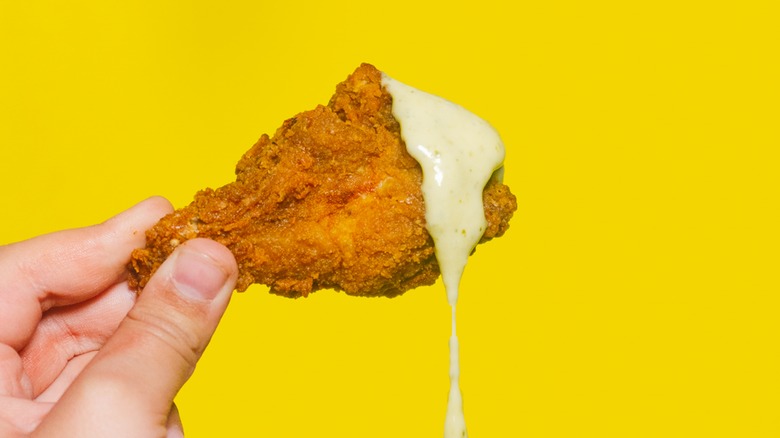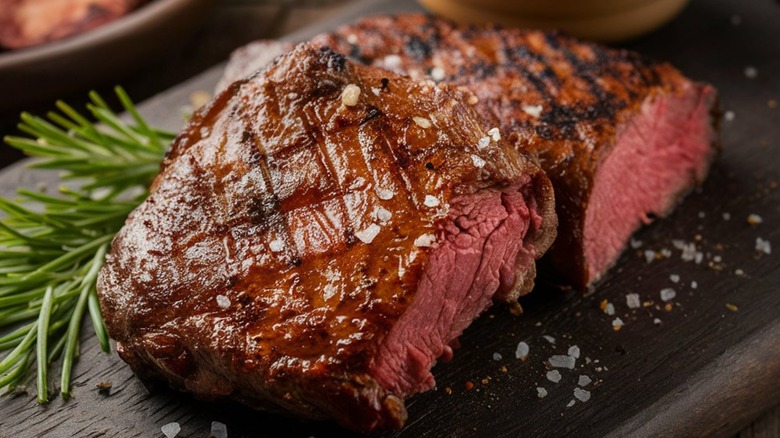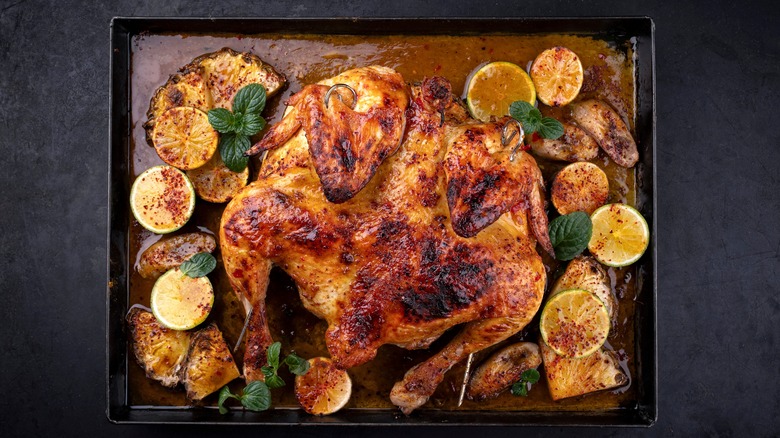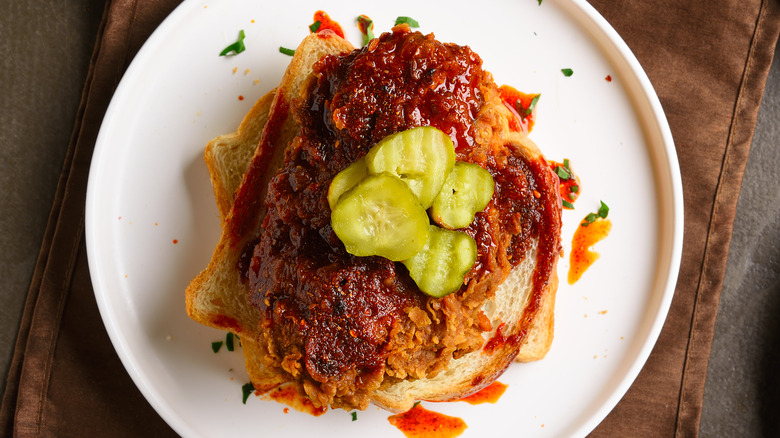A Comprehensive Guide To Barbecue Sauce Across The US
While some barbecue sauce styles are popular all around the world, there are well-known and lesser-known regional variations from all over the United States. From popular options like Kansas City barbecue to special gems such as Alabama white sauce, these are the sauces you have to try to get a full run of barbecue tastes. You can find barbecue sauce from coast to coast and different cooking techniques for barbecuing meat, as well. Some areas stick with grilling for a flavorful charred crust, while others are known for smoking meat in pits for hours to get delectably tender meat.
Barbecue sauces can be categorized based on their primary ingredient: tomato, vinegar, mustard, or mayonnaise. However, many combine multiple bases, as well as other flavorful ingredients like spices, fresh garlic, and even peppers and hot sauce to create a blend that works with barbecued meats and vegetables. Some types of barbecue sauce are known for pairing especially well with different meats, although many can be used in a variety of applications. Whether you are firing up the grill or smoking low and slow over wood pellets, these sauces are the way to turn your barbecue into a world-class feast.
Kansas City barbecue sauce
When most people picture barbecue, they think of thick, sweet Kansas City-style sauce that has just enough kick to get your tastebuds begging for more. It is tomato-based with ketchup and tomato paste or sauce as two of the staple ingredients. But true KC barbecue has a unique sweet sauce, which gives it extra flavor and makes it stick to your dishes and your belly. Kansas City barbecue sauce tends to be the richest and thickest sauce out there thanks to this syrupy base. Vinegar also brings in some tangy acidity, although it's important to note that KC barbecue is not vinegar-based. Instead, the vinegar is a small addition meant to work with the other flavors. The exact seasoning blend can vary but typically includes garlic powder, onion powder, paprika, and a bit of chili powder. The brown sugar and molasses are the more important ingredients, however, and the spices used are meant to complement them.
Kansas City barbecue is known for being one of the heartier options out there and is perfect with burnt ends, a Kansas City specialty. It is also delicious slathered over brisket, ribs, or just about any barbecued meat. KC barbecue often uses dry rub in addition to this rich, sweet sauce for meat that is both flavorful and extra moist.
Carolina vinegar barbecue sauce
North Carolina barbecue sauce is one of the most famous vinegar-based sauces and it packs a bit of a kick, depending on how you spice it up. It is popular in Eastern North Carolina, where it is served on everything from pulled pork to brisket. Apple cider vinegar gives it a tangy but sweet flavor that goes well with pulled pork. You can find pulled pork at roadside barbecue spots that's been smoking for hours and it comes drenched with vinegary sauce. Many restaurants serve extra sauce on the side so that you can add extra to your sandwich or even dip your fries in it for an extra tangy taste.
A simple recipe adds cayenne pepper and hot sauce but there are plenty of small batch options that have their own take on the spices included. What they all share is the most important ingredient: vinegar. Carolina sauce tends to be thinner than thick Kansas City barbecue sauce, its top rival for the best-known sauce.
Carolina gold sauce
What gives Carolina gold sauce its golden color is its main ingredient, yellow mustard. Carolina gold sauce began in South Carolina when German immigrants settled in the area, bringing their love for mustard with them. It is especially tangy, just like Eastern North Carolina sauce, thanks to the addition of vinegar to the mustard base but it also has a bit of sweetness from added sugar or honey. The yellow mustard is critical for the distinct color of this sauce so most stick with this simple condiment as a base rather than branching out with dijon or grainy mustard.
Carolina gold pairs well with pork and chicken but is especially delicious with sausages, another culinary tradition brought over by German immigrants along with their mustard sauce. Depending on the mustard-to-vinegar ratio, it can be thick or thin. Spices like onion powder and garlic powder are usually added, although it usually gets most of its flavor from the mustard instead of a strong spice blend.
Texas barbecue sauce
Everything's bigger in Texas so it shouldn't be surprising that even within the Lone Star state, there are multiple variations Texas barbecue sauce. East Texas sauce has the most similarity to other styles due to its proximity to the vinegary sauces of the South. Cumin and chili powder combine with a vinegar base but tomato paste and even Cajun flavors can come in sometimes. Barbecue in East Texas is especially smokey and deep compared to many other regional barbecue sauces thanks to marinades and spice blends. East Texas has the sauciest type of barbecue in the state.
Central Texas focuses more on dry rub and smoking over specific types of wood to bring out the meat's flavor when preparing barbecue. Beef, particularly brisket, is popular there and has a strong influence over the rest of the state as well. West Texas also uses wood but favors open flame grilling and pit barbecue as the staple of its cuisine. Southern Texas borrows flavors from Mexican cuisine and slow-cooked brisket and barbacoa are two popular dishes.
Virginia barbecue sauce
Like in Texas, there are variations on barbecue sauce within Virginia depending on where you are in the state. In general, Virginia sauce is vinegar-based, similar to nearby North Carolina sauce and Carolina gold from South Carolina. The barbecue served in the mountainous western parts of the state can be much different from that in the eastern coastal regions, with many family secret sauces on the menu at popular restaurants. But apple cider vinegar is a staple ingredient in most versions, which makes it thinner than some other regional barbecue sauces like thick Kansas City sauce.
Barbecue sauce in Virginia includes plenty of herbs and spices, which gives it a strong flavor, but the exact blend varies not just by region but by individual chef. Many restaurants stake their claim on the recipe passed down through generations and patrons usually have their go-to favorites. Tomato paste or tomato sauce is usually a main ingredient in many Virginian sauces so it's a bit more substantial than true vinegar sauce but because it doesn't include molasses, it's not thick and syrupy. Some varieties also add mustard to give it a distinct brown color and tangy flavor. There are even versions with apple butter, fruit, or peanut butter mixed in for a truly distinct flavor.
Korean barbecue sauce
Soy sauce and ginger, among other ingredients, give Korean barbecue sauce its distinct flavor. It is especially popular in Hawaii thanks to the strong influence of Asian cuisine on the islands. Soy sauce serves as the base for the sauce but rice wine vinegar and sesame oil also bring flavor to the sauce. Fresh garlic and ginger are also important, although you can use powdered versions as well for a similar flavor. Some versions include brown sugar for sweetness. This sauce can be used as a marinade or as a dipping sauce, although you shouldn't use the same batch of sauce for both marinating raw meat and dipping cooked meat.
Korean barbecue restaurants can be found all over the United States and a big part of the experience is sharing it with other diners. That's why many restaurants don't serve individual patrons. Traditional Korean barbecue lets you grill your meat and veggies at the table using a special stove, choosing from a selection of marinades and sauces that complement various cuts of meat. In restaurants, the stove can be electric, gas, or wood-burning and typically has built-in ventilation over the table. At home, you can use a small tabletop grill but make sure to do this outdoors or open windows for adequate ventilation. This fresh-off-the-grill aspect is important not just to customize your food to your preferences but also to the overall dining experience.
Memphis barbecue sauce
Memphis sauces add vinegar and mustard to tomato-based barbecue sauce. Most versions start with ketchup, giving it a similar acidity to Kansas City-style barbecue sauce. But the addition of yellow mustard and apple cider vinegar gives it a bit of twang and extra flavor, much like Memphis where it is popular on pork. You can also find it served with beef or chicken but pork is the meat of choice for Tennessee barbecue. Pit cooking, which is done slowly over low heat, is important to preparing traditional Memphis-style barbecue.
Spices like onion powder and garlic powder are important in this sauce but it also gets a little kick from cayenne pepper and chili powder. Some versions have more heat than others but overall Memphis-style barbecue sauce is known for being more twangy than spicy. It often has brown sugar for a touch of sweetness but it's not as sweet or syrupy as KC barbecue because it doesn't include rich molasses. You can find Memphis barbecue sauce on pork, beef, and chicken sandwiches along with barbecue spaghetti, another Memphis regional dish.
St. Louis barbecue sauce
St. Louis barbecue isn't as famous as its neighbor from Kansas City but it uses many of the same ingredients starting with tomato paste, tomato sauce, and ketchup as a base. Similar to tomato-based Kansas City barbecue sauce, the St. Louis variety adds extra vinegar with a similar spice blend of onion powder, garlic powder, and cayenne. It omits the thick molasses common in KC sauces, which makes it thinner and less sweet. However, brown sugar still brings a balance of acidity and sweetness to the sauce. Yellow mustard is typically used as well in small quantities.
It's perfect for slathering on St.Louis-style ribs and pork steaks. Pork steaks are unique to St. Louis and common in the city from barbecue restaurants to backyard get-togethers. Pork steaks are made with thin cuts of pork shoulder or butt, which is grilled and slow-cooked in St.Louis-style barbecue sauce. You can get them specially cut in butcher shops around the country but will find them in most butcher cases in St. Louis ready to go.
Lexington dip sauce
This sauce is specific to Western North Carolina, where it is called dip. It is vinegar-based but includes ketchup and brown sugar. Lexington dip starts with the thin vinegar and pepper sauce popular in Eastern North Carolina but adds ketchup for acidity and sugar for sweetness, plus extra seasoning and spices. This sauce includes cayenne pepper and red pepper flakes but is less peppery than Eastern North Carolina sauce. It is still thinner than other tomato-based sauces like that from Kansas City thanks to the heavy vinegar base that has become a type of sauce all its own.
Lexington dip sauce is popular served over pork like many other Carolina barbecue styles, especially pork shoulder. But in Carolina, the pork shoulder is roasted slowly over low heat and then chopped rather than pulled. Lexington dip also pairs well with chopped beef. In the Lexington area, it's typically served on sandwiches topped with coleslaw, which can come on the side or piled high on top of the meat within the sandwich.
Alabama white sauce
There aren't as many mayo-based barbecue sauces out there, but the Alabama white sauce is one worth noting. This white barbecue sauce uses mayonnaise as a base with vinegar adding a distinct twang to the creamy base. Other flavors come from brown sugar, lemon juice, horseradish, and a hint of cayenne pepper. The original sauce was pretty simple, but it's been developed over the years to work as a bottled sauce, as well as being sold in the same restaurant where it started.
Alabama white sauce started in the 1920s when "Big Bob" Gibson made it for his family and friends at backyard cookouts hosted at his home. He combined mayo with vinegar to create the sauce, which he used with chicken and pork that he slow-roasted in pits he dug by hand. Local theory states that he got the idea because he wanted to keep the roasted meat moist after they cooked it but but before serving it. A mayo and vinegar mixture was the perfect solution and also added flavor to the dish. Gibson eventually opened a restaurant, which is still family-owned and serves the same white sauce he created.
Santa Maria barbecue sauce
This method of barbecue began in Central California's Santa Maria Valley and is a little-known secret of the region. While it doesn't get the same national recognition as other barbecue styles, it has a dedicated local following and is celebrated for its unique blending of culinary influences over the area's history. Santa Maria-style barbecue is about the cooking method as much as the ingredients and includes beef tri-tip or sirloin roasted over red oak. It has a distinct smoky flavor thanks to the wood.
Traditionally, pinquito beans pair with the meat similar to a sauce. Cook pinquinto beans are simmered with a sauce made of tomato puree, mustard powder, brown sugar, Worcestershire sauce, ham, bacon, and spices. These beans are native to California and are served with barbecued meat on a platter. If you can't find piquinto beans, you can also use Navy beans. You can also find Santa Maria barbecue paired with salsa, which is slathered over the top for a bit of zing and spice.
Florida barbecue sauce
Florida-style barbecue sauce has strong citrus flavors as well as some spiciness courtesy of Cuban influences, especially as you move further south in Florida. With plenty of access to fresh citrus and berries, small-batch barbecue sauces often use Florida ingredients like oranges, berries, and hot peppers. Many recipes call for orange juice as a splash of bright acidity, similar to what tomatoes bring to other barbecue sauce varieties.
It often starts with vinegar and tomato paste or tomato sauce, like other tomato-based barbecue sauces. Brown sugar and honey sweeten things up while liquid smoke and Worcestershire sauce add depth. But the addition of fruit, especially citrus, gives it a distinctly Florida taste and make it a brighter sauce overall. Hot sauce or cayenne pepper adds some heat, although you can find sauces with less or more spice to suit your preferences. Florida barbecue sauce is often paired with smoked fish, which isn't surprising, given the lengthy coastline in the Sunshine State.
Nashville barbecue sauce
This sauce combines the vinegar base of the nearby Carolina-style sauce with sweet notes similar to that of Kansas City or St. Louis. While it's close to the other types of Tennessee barbecue, particularly sauces that hail from Memphis, Nashville barbecue sauce includes brown sugar, a touch of molasses, and liquid smoke in most recipes that makes it different from the ingredient list in Memphis-style sauce or Carolina vinegar barbecue. The liquid smoke in particular adds a deep smokiness that is pure Nashville.
Like other Tennessee barbecue spots, Nashville restaurants slather this sauce on pork primarily, although it's also tasty on beef and chicken. It's often served with pulled meat on a sandwich with tangy slaw and pickles on top. When you're in Nashville, you'll often see Nashville-style barbecue at many of the best barbecue restaurants throughout Nashville, where it's typically available for lunch as a sandwich or as a dinner platter.
